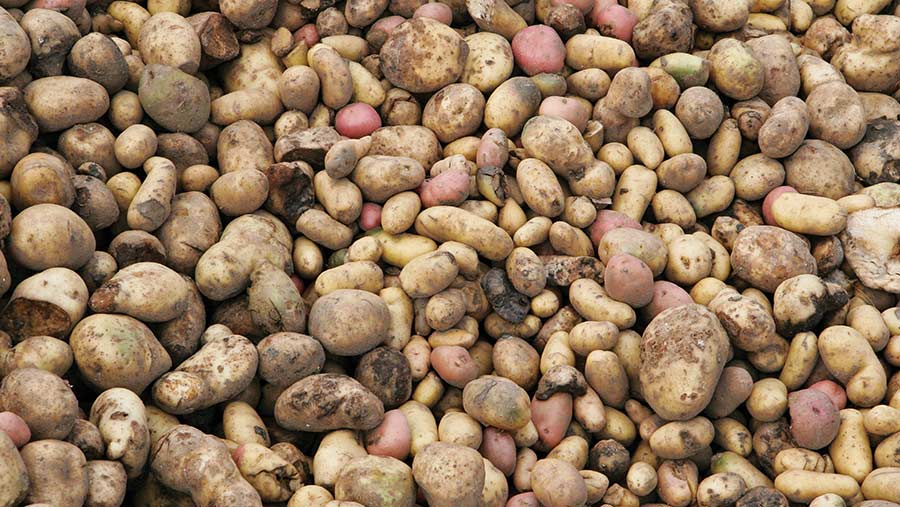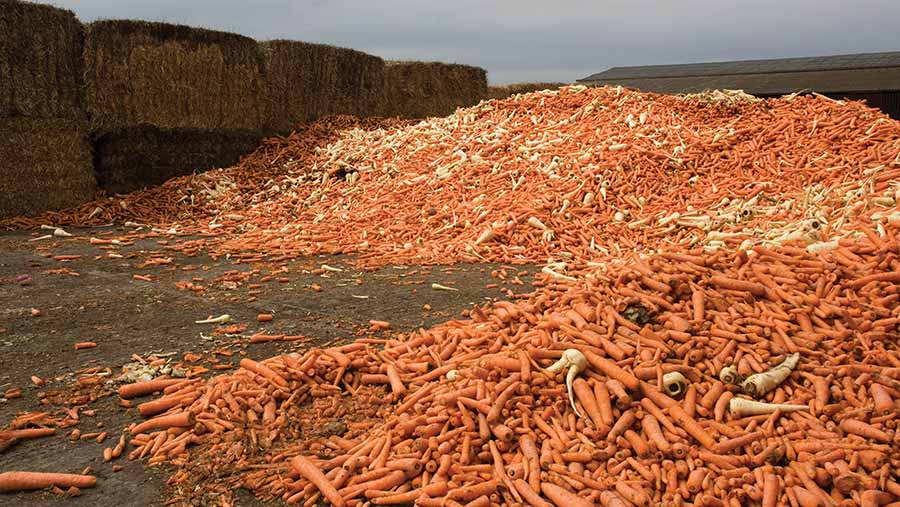Best Cow Feed for Beef Cows
Alternative feeds, or co-products, are unremarkably derived as a by-product from food or drink manufacturing, and can offer a relatively inexpensive source of nutrients.
But quality tin can vary widely, and co-products rarely provide a complete feed for beef cattle.
Therefore, it is essential that nutritional analysis is carried out on individual feed to formulate a well-balanced ration around it, says AHDB beefiness scientist Rebecca Small.
This often means including good-quality, domicile-grown forage as a foundation to provide the correct rest of poly peptide, energy and fibre to optimise rumen function.
Meet also: How beef processor Pickstock improved output past £560/ha
Overall, the ration must be tailored to the breed, type, sex and phase of production.
Another event that must non be overlooked is farm assurance. The specific details of the farm'due south assurance scheme should exist checked considering most will stipulate purchased feeds are supplied by certified companies, she says.
Here, Ms Pocket-sized looks at the different options bachelor, the rates at which they should be included and their nutritional value.
- Roots
- Bakery/Confectionary
- Fruit
- Considerations for feeding
- Case study
Roots
Storage tin can exist problematic with fresh roots, such as carrots, potatoes and parsnips, and stocks may demand to exist bought in often to maintain quality. Hot or very cold weather can crusade deterioration, and so a cool, dry and well-aerated store is needed.

© Tim Scrivener
Potatoes
Diet inclusion is up to lxx% dry affair (DM)
Nutritional value:
- High starch free energy
- Depression fibre
- Low protein
Typical breakdown:
- DM: 20.v%
- Neutral detergent fibre (NDF): 13.iii%
- Crude protein: eleven% DM
- Metabolisable energy (ME): thirteen.5MJ/kg DM
Carrots
Diet inclusion is up to 45% DM
Nutritional value:
- High energy
- High fibre
- Low protein
Typical breakdown:
- DM: thirteen%
- NDF: 10.5%
- Protein: 9.5% DM
- ME: 12.6MJ/kg DM

© Tim Scrivener
Parsnips
Diet inclusion is up to 50% DM
Nutritional value
- High free energy
- High fibre
- Low protein
Typical breakdown
- DM: fifteen%
- NDF: 14.5%
- Protein: viii.6% DM
- ME: 13MJ/kg DM
Bakery and confectionery
Biscuit is highly palatable and can be fed in place of cereals. It also has a loftier energy content due to the corporeality of oil it contains. However, the oil content also means the product cannot be stored for long periods.
Bread is a readily available, high energy, palatable feed source. But it has a lack of digestible and structural fibre, preventing high inclusion rates. Mould develops rapidly on the outer surfaces, which could crusade health issues, and this curt shelf-life means deliveries have to be frequent.
Breakfast cereal makes a good replacement for concentrate and has a very good palatability and a high energy percentage. Depending on type, however, it can exist low in fibre.
Biscuit blends
Diet inclusion is up to 30% DM
Nutritional value:
- High energy
- Low fibre
- Low poly peptide
Typical breakdown:
- DM: 88%
- NDF: 20%
- Protein: ix.five% DM
- ME: 15MJ/kg DM
Bread
Diet inclusion is upward to 30% DM
Nutritional value:
- High energy
- Low fibre
- Moderate protein
Typical breakdown:
- DM: 65%
- NDF: 10%
- Protein: fourteen% DM
- ME: 14MJ/kg DM
Breakfast cereals
Diet inclusion is upward to 30% DM
Nutritional value:
- High free energy
- Low fibre
- Low protein.
Typical breakdown:
- DM: xc%
- NDF: 11%
- Protein: 12% DM
- ME: 14MJ/kg DM
Fruit
Citrus pulp in moisture or dry forms can be used equally a high energy, high-fibre supplement. But palatability varies according to the fruit base. Storage for wet pulp is less simple merely can maintain quality for up to six months in a clamp.
Dry citrus pulp
Maximum nutrition inclusion is upward to 40% DM
Nutritional value:
- High energy
- High fibre
- Very low poly peptide
Typical breakdown:
- DM: 89%
- Fibre: 21%
- Protein: 7% DM
- ME: 12.5MJ/kg DM
Wet citrus pulp
Maximum diet inclusion is up to thirty% DM
Nutritional value:
- High energy
- High fibre
- Low poly peptide
Typical breakdown:
- DM: 24%
- Fibre: 37%
- Protein: half dozen.five% DM
- ME: 12.2MJ/kg DM
Storage consideration for waste material products
Storage requirements depend on the physical class of the feedstuff, which is commonly categorised every bit dry, moist or liquid.
Dry out feeds (pelleted, grains or meal) are the easiest types to shop with clean bins, hoppers, floors or trailers, all being suitable. Any shelf-life recommendations must exist taken into business relationship.
Facilities for moist and liquid feeds require more than planning to preclude nutritional deposition and potentially polluting losses.
If the moist feed is to be stored through wintertime or other long periods, it may need to be clamped if appropriate. As with ensiling any crop, a clean side and peak canvas should be used and held downward with a heavy material to ensure the sheet is in contact with the feed.
All liquid feeds require storage in clean tanks or drums to foreclose contamination or fermentation that can atomic number 82 to illness issues.
Example study: Beefiness finishers John and Jim Brownish, Gaindykehead, nearly Airdrie
Father and son Jim and John Brown use potato rejects and waste mashed potato to finish ii,300 to ii,500-head of cattle a twelvemonth at their subcontract, near Airdrie in Lanarkshire.
The spud-based products would be packed for supermarkets. A lot of the potatoes and brew are rejected for pocket-size blemishes because retailers demand product uniformity. But they are still fresh and good enough to eat in nutritional terms, says Jim.
To ensure freshness is maintained, the Browns haul potatoes v days a week from the processing factory two miles away. Frequent pickups overcome the need for large storage areas on the farm, reducing spoilage.
The potatoes are mixed with silage for feed one time a twenty-four hour period – in the morning, so pushed upward in the afternoon. Potatoes are fed whole so there is a adventure of choking, warns Jim. However, this has proved to be a small run a risk and the farm has successfully used the arrangement with few incidents since 1972.
The alternative is to scissure or shell the potatoes, but this causes the starch content to break downward, turning them blackness. "We would accept to feed potatoes twice a solar day to proceed them fresh and palatable if we croaky them starting time," he explains.
John manages the farm and says potatoes need to be introduced to the ration gradually. Cattle are bought in at about 500kg, just they have never eaten potatoes before, then they tend to avoid them initially.
The potatoes stand for the energy content, so the starter ration includes 2kg of barley, which is fed for the first 50 days on the subcontract.
Starter ration includes:
- 10-15kg silage
- 2kg barley
- 100g urea
- 5kg (rising to 40kg) potato – either whole or mashed.
Cattle and then motility to a finisher ration for the remaining 50-lx days.
Finisher ration includes:
- 5-6kg silage
- 1kg brewers barley
- 100g urea
- 40-45kg whole irish potato
- 5kg mashed potato.
The waste potatoes are regularly analysed so the ration can be adjusted if quality changes. About 5kg of mashed spud is equivalent to feeding 1kg of grain, says John.
But low-protein and low-fibre levels mean the ration is anchored past high-quality silage at about 13-14% protein and 30% DM.
Benefits
Growth rates vary according to breed and conformation, but cattle tin achieve daily liveweight gains (DLWG) of up to 2kg/day.
The average DLWG is 1.3kg beyond 110 days on the subcontract, taking them from 500kg to 700kg.
Source: https://www.fwi.co.uk/livestock/livestock-feed-nutrition/alternative-feeds-for-beef-compared
0 Response to "Best Cow Feed for Beef Cows"
Postar um comentário